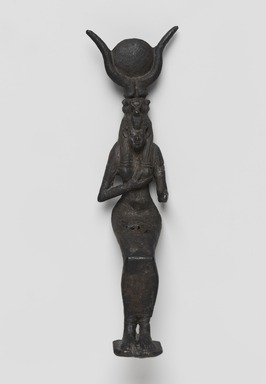
Medium: Bronze
Geograhical Locations:
Dates:664-525 B.C.E. or 305-30 B.C.E.
Dimensions: 37.591Ea: 5 1/16 × 1 9/16 × 2 1/4 in. (12.9 × 4 × 5.8 cm) 37.591Eb: 1 5/8 × 1/2 × 1 11/16 in. (4.1 × 1.3 × 4.3 cm)
Collections:
Accession Number: 37.591Ea-b
Image: 37.591E_PS11.jpg,
Catalogue Description: The goddess holds right hand to left breast. Left forearm is extended to support Horus. Goddess wears a lappet wig with uraeus. From the top of the wig springs circular frieze of uraei from which rises cow’s horns and disk. Hole in goddess’ lap for the insertion of tenon of Horus. Broad collar, double crown are shown. A tenon descend vertically from buttocks. The uraeus on the brow of the goddess also the headdress of Horus and a disk. The god does not wear amulets, bracelets and anklets. The child wears the double crown of Egypt and an amulet suspended below his broad collar. A rounded knob-like tang under the thighs, and another under the thin bases served for attachment to the lost seat. A tang on the Horus figure was the means of fastening it to the lap of Isis. Condition: a) Brown/black patina highlighted here and there by cuprite deposits. Surface covered with lead salts esp. dowel hole for insertion of b. The figure shows some evidence of modern feeling, especially about the tang. b.) Dowel lead carbonate incrusted. Little superficial pitting.